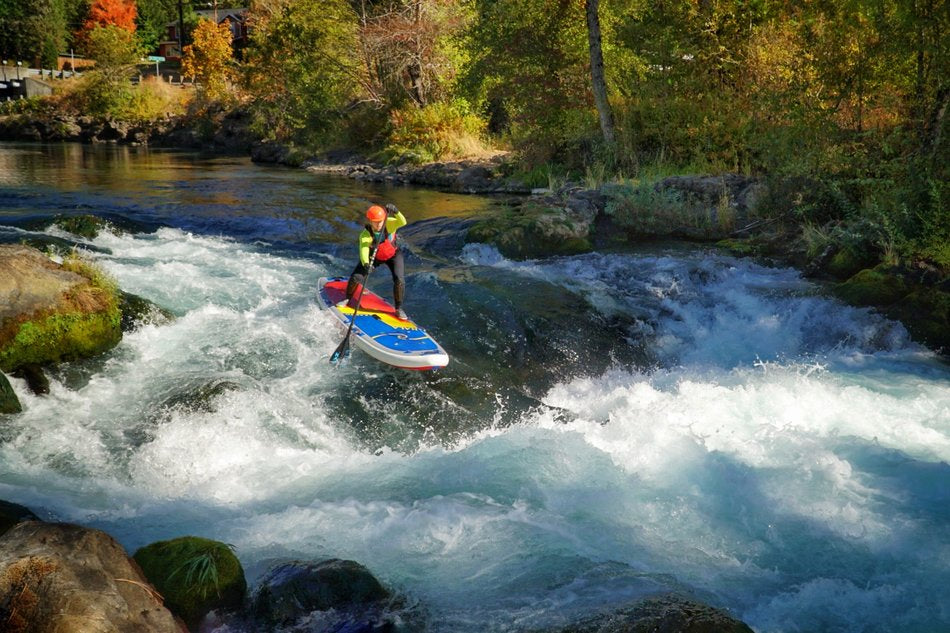
The Mental Tricks of SUP Adventurer
Forget functional fitness. If you want to run whitewater on a SUP, you need focused fitness.
Paul Clark has lived a hell of a life. The 46-year-old spends most of his time paddling whitewater all over the world, but he’s also been a professional sea-kayak guide in Alaska and Baja, Mexico, an Outward Bound instructor, a ski patroller, and an avalanche-rescue dog handler. He’s thru-hiked the Pacific Crest Trail, lived in a snow cave for 83 days, and paddled the 1,000-mile Sea of Cortez solo (twice).
Now, as Clark pushes into his late forties, he’s into stand-up paddleboarding, which he discovered six years ago. He focuses on whitewater SUP and self-supported multi-day expeditions, paddling stout rivers like the Kaituna in New Zealand and the Petrohué in Patagonia. “Solo pedestrian sports have always been my chosen aesthetic,” Clark says. “Whether I’m using a pair of skis, or a kayak, or a paddleboard, the idea of dictating my own pace and moving at my own power has always been my thing.”
Clark, who has made a living from outdoor pursuits for two decades, lives out of his van and spends much of his time on the road, creating content for brands and teaching SUP clinics. This year he’s already paddled 40 rivers on his SUP in Oregon alone. With a knack for knocking out Class III and low Class IV rapids with grace, Clark says that SUP seems to have broad appeal for older, experienced athletes like himself. “I was never comfortable confined in a kayak when running rapids,” he says. “But a paddleboard is different. As soon as I figured out you could load a drybag on the front of the board and actually do a multi-day trip on the thing, I was hooked.” Most of his students are advanced whitewater kayakers looking to avoid the risk that comes with Class III kayaking but still stay entertained as they reach their forties. “It’s not about getting radical. It’s about exploring the landscape,” Clark says. “Paddleboarding gives you a whole new way to learn the river.”
While he and other whitewater SUP paddlers aren’t running tall waterfalls or Class V wave trains, that doesn’t mean the sport isn’t physically demanding. Clark says that whitewater SUP requires a specific style of physicality and mental aptitude that isn’t<strong> </strong>present in other adventure sports. When his life was dominated by skiing, sea kayaking, and hiking, Clark managed to avoid any sort of regimented fitness routine, relying instead on the adventures themselves to provide the workouts he needed. But as his focus has shifted to paddleboarding in the past couple of years, his attitude has changed. “I see now that if a person my age isn’t constantly active, the body and brain starts to break down. Inertia is a terrible thing,” he says.
Instead of functional, all-around fitness, Clark is more concerned with focused fitness, which zeros in on movements he needs while on the river and emphasizes muscle memory and the connection between the brain and body. Clark always carries a 15-pound kettlebell and a custom-designed 15-pound kettle bat in his van—whenever he stops, he knocks out a handful of weighted squats and lunges, holding a stance at the bottom of the movement and rotating. These exercises are particularly important before he gets on the river, so his body is used to being low and centered. “Whitewater is a slow sport. It’s not like skiing or mountain biking, where you’re approaching a feature at 20 miles per hour. You have to brace and hold a position for a long time. There are elements of balance, agility, and core strength, but really you have to have some specific movements down so you don’t have to think about them,” Clark says. “You want muscle memory to kick in.”
Besides exercises that help lower his center of gravity, Clark insists that developing mental fortitude is a huge key to successful whitewater paddling. “The less you’re in your mind, and the more you let your body just move, the more success you’ll have,” Clark says. “When I teach clinics, I can see in people’s eyes if they’re gonna fall. If there’s fear, if they’re in their head, they’re toast.”
Board Training with Paul Clark
Clark has his students run through these exercises as soon as they get on the board. “The idea is to get your body used to staying centered and low,” he says.
In a calm section of river, start paddling on your knees. Peel into an eddy, then peel out. The action of paddling in and out of this placid stretch of water will force your body to work through a range of motions and positions.
Next, move to one knee, with the other foot in front of you. Peel into the eddy and peel out. Switch knees and repeat the process.
Stand in a squatting position on both feet. Try to keep your torso erect but your butt low toward your heels. Your head should be about the same height as when you were kneeling.
Article written by Graham Averill for Outside Magazine.



Leave a comment
This site is protected by hCaptcha and the hCaptcha Privacy Policy and Terms of Service apply.